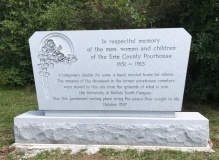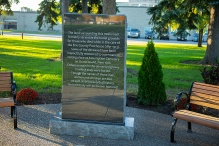Erie County Poorhouse Cemetery
Updated August 27, 2019
Excavations and construction on UB South Campus have periodically uncovered skeletal remains and remnants of wooden coffins. Historians believe that these were the result of burials of residents of the Erie County Poor House, which operated on the site of UB’s South Campus from 1851-1913.
On this page:
In 2012, UB sought and obtained a court order that gave the university authority to exhume remains uncovered during construction projects. The order also granted UB the authority to analyze the exhumations in accordance with prevailing practices and ethical treatment of the remains for research and historical purposes. Under this order, UB has the legal authority to store and reinter the remains in a cemetery.
Exhumation and storage of remains was overseen by faculty from UB’s Department of Anthropology and was conducted in keeping with the standards of professional scientific inquiry and in accordance with the court order.
Remains had been discovered in a concentrated area on the western side of the South Campus centered on Michael Road. The remains mainly consist of skeletal fragments, bits of burial clothing and wood from coffins.
UB’s researchers estimate that at least 3,000 individuals were buried at the site.
On Oct 11, 2017, the university reinterred the remains of 372 individuals at Assumption Cemetery in Grand Island after a non-denominational reinternment ceremony and committal service.
On Monday, Nov. 26, at 3 p.m., the university held a dedication ceremony at the site of a new memorial garden to honor those who died in the care of the former Erie County Poorhouse and were buried on land that is today part of UB’s South Campus.
Meaningful research on Western New York history
Since the remains were discovered in 2008 and 2012, a research team from the UB Department of Anthropology had conducted extensive research to tell the story of these individuals and create a picture of what life was like for them in Buffalo during a period in the two previous centuries. The Department of Anthropology also sought to locate the boundaries of the cemetery to determine the identity and number of individuals who were buried there through archival and anthropological research.
It’s important to note that specific identities were not able to be denoted, but that scientific analysis and documentary research have yielded descriptions of gender, age and ethnic origin.
This analysis, conducted by physical anthropologists under the leadership of Distinguished Teaching Professor Joyce Sirianni, provided important insight on the health and morbidity of a specific population: Western New Yorkers living in poverty in the 19th and early 20 centuries.
The project had given UB students the opportunity to conduct meaningful research that adds significant information to the historical knowledge we have about our local community.
Under the leadership of UB archaeologist Douglas Perrelli and UB physical anthropologist Joyce Sirianni the findings of this research has been presented at research conferences nationwide and is available to the general public.
UB’s archaeological fieldwork ended in September 2012, with no further discoveries of human skeletal remains associated with the current construction project since that time.
Respectful treatment of the remains
The University at Buffalo held a non-denominational reinternment ceremony and committal service on Wednesday, Oct. 11, at 11 a.m. at the UB Newman Center, 495 Skinnersville Rd., Amherst.
The ceremony and service, officiated by Rev. Msgr. J. Patrick Keleher, Director and Campus Minister for the Newman Center and SUNY Distinguished Teaching Professor Joyce E. Sirianni, Pastor of Faith United Presbyterian Church, commemorated the lives of 372 people buried between the mid-19 and early-20 centuries on the grounds of the former Erie County Poorhouse cemetery, near the edge of what today is the university’s South Campus.
University remarks were given by Laura E. Hubbard, vice president for finance and administration.
A funeral precession left the Newman Center at the conclusion of the ceremony and proceeded directly to a committal service at 1 p.m. at Assumption Cemetery in Grand Island.
The October 11th events at the Newman Center and on the grounds of Assumption represent the culmination of approximately nine years of devoted work at the confluence of dedicated science and compassionate humanity by UB researchers and several community partners that began after construction crews discovered the first of the poorhouse’s 372 gravesites, uncovered during a Bailey Avenue lighting project in 2008 and again in 2012.
Their meticulous and respectful efforts restores the dignity and individuality of the deceased that had been previously lost amidst a forgotten history and allows for the remains to now be moved to a permanent resting place on hallowed ground.
Any remains uncovered during future South Campus construction projects will be reinterred at Assumption Cemetery in Grand Island; all remains will be treated properly and respectfully, and will be memorialized for posterity. A monument marks the reinterred location for the deceased with the following inscription:
In respectful memory of the men, women and children of the Erie County Poorhouse 1851-1913. A temporary shelter for some, a much needed home for others. The remains of the deceased in the former poorhouse cemetery were moved to this site from the grounds of what is now the University at Buffalo South Campus. May this permanent resting place bring the peace they sought in life.
Memorializing former Poorhouse residents
The university has created a new memorial garden to honor those who died in the care of the former Erie County Poorhouse and were buried on land that is today part of UB’s South Campus.
The South Campus memorial garden is situated immediately to the west of Clark Hall and is accessible by way of Rotary Road. The landscaped garden is enclosed by a circular walkway with a roughly 6-foot monument of American black granite that is flanked by park benches. The inscription reads:
The land surrounding this monument formerly served as the burial grounds for those who died while in the care of the Erie County Poorhouse (1851-1913). Some of the deceased have been respectfully reinterred to a permanent resting place at Assumption Cemetery on Grand Island, New York. Others remain in the unmarked graves in which they were buried. Though the names of those men, women and children are lost as part of an unrecorded history, the spirit of their identity and the dignity of their memory will be forever honored.
Frequently Asked Questions
In 2012, UB sought and obtained a court order that gave the university authority to exhume remains uncovered during construction projects. The order also granted UB the authority to analyze the exhumations in accordance with prevailing practices and ethical treatment of the remains for research and historical purposes. Under this order, UB has the legal authority to store and reinter the remains in a cemetery.
Following their removal from the ground, many of the wooden coffins were found to have sustained significant water damage. The UB team, under the leadership of UB archaeologist Douglas Perrelli and UB physical anthropologist Joyce Sirianni, together with a team of graduate students, spent a full year cleaning, examining and studying each set of individual remains. The remains were reinterred the following year, in 2013.
DNA was used to determine geographical ancestry of remains, but could not provide individual identities.
The 367 sets of remains were relocated to established cemeteries, including Assumption Cemetery on Grand Island.
- Many options were discussed before a determination was made that the most respectful course of action was to reinter the remains on the sacred grounds of an existing cemetery. There are plans to later memorialize the original location of the cemetery with a South Campus monument.
- Assumption Cemetery on Grand Island was chosen because of its proximity to the university (within 10 miles) and because it has capacity to bury the current group of remains, as well as the remains that may be unearthed during future excavations at UB’s South Campus over the next several decades.
No. Remains could not be reinterred on university land. All remains, after having been cleaned, identified and studied, were reinterred in approved cemeteries.
- There are a few fully articulated skeletons, but in other instances researchers found only an isolated bone fragment, some as small as a coin.
- The deceased were exhumed as individuals and they are being reinterred the same way. In many cases, the remains of individuals are composed of a small amount of bones or fragments of bones. Individual remains are sealed in separate burial pouches each marked with stainless steel identification and placed in one of the eight coffins.
- Assumption Cemetery on Grand Island was chosen by the university and its community partners because it has capacity to bury the current group of remains as well as remains that may be unearthed during future excavations at UB’s South Campus over the next several decades. The university also wanted to choose a cemetery that was close, within 10 miles, to the original burial location on the South Campus.
- Although researchers believe most of the deceased were Catholic based on religious artifacts found in the coffins, that Assumption is a Catholic cemetery was not the determining factor in its selection as a reinterment site.
- Catholic Cemeteries of Buffalo generously offered to work with the university and Assumption had the capacity to accommodate the needs of reinterment. It’s also worth noting that Catholic Cemeteries serve non-Catholics as well as Catholics.
- Yes, UB’s researchers estimate that an additional 3,000 individuals could be buried in the former poorhouse cemetery on what is now UB’s South Campus.
- When more remains are excavated at the university, they will be reinterred at Assumption Cemetery on Grand Island.
- A court order gives the university authority to exhume remains uncovered during construction projects and reinter the remains in a cemetery.
- Gravesites around the country are being unearthed by development and there is little guidance and no funding for this problem. UB has established respectful reinterment procedures that preserve the dignity of the deceased. In fact, another group has already contacted the university to discuss how UB addressed reinterment.
- The combined efforts of university researchers and its community partners have from the beginning established a respectful and dignified process addressing exhumation and reinterment. The expertise of UB’s community partners played a very important role in the reinterment process. UB’s community partners included members from the Erie Niagara Funeral Directors Association, Stone Art Memorial; Catholic Cemeteries of the Diocese of Buffalo; the Wilbert Vault Company; and the New York State Division of Cemeteries.
- At the turn of the 20th century, institutions simply did not possess the sensitivity to these issues that we possess now. As a society, we’re now much more sensitive to the immense importance of respecting and honoring our ancestors, preserving their histories and learning from them.
- That is why the university has now taken such elaborate steps to research who these people were, respectfully honor them and provide them a dignified final burial place.
- The discovery was made in 1964 during construction of Clement Road. At the time, 170 burials were removed from the site. As far as the university is able to determine, there isn’t a record of the decision-making that led to the relocation of the remains in 1964.
- With greater sensitivity to these issues, the university from 2008-17, developed an approach that not only honors the memories of the deceased, but has created a dignified model that others can follow as these discoveries become more common in the presence of expanding development.
- In 2017, the university held a reinternment ceremony following the discovery of human remains uncovered during a construction project along Bailey Avenue.
- This coordinated effort relied on the expertise of UB faculty researchers and a team of dedicated community partners. It helped establish a compassionate and respectful reinternment process that didn’t exist decades earlier.

